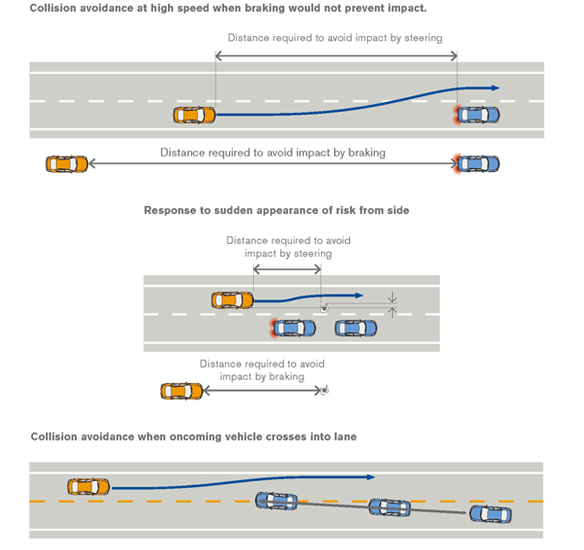Autonomous Emergency Steering System
Automatically steers to help avoid accidents when a potential collision is detected
When
an
obstacle
appears
suddenly
in
front
of
a
vehicle,
the
driver
may
be
required
to
make
a
number
of
judgments
and
decisions.
“What
has
appeared?”
“Should
I
steer
to
avoid
a
collision?
Should
I
brake?”
But
when
there
is
an
impending
collision,
a
driver
may
not
react
fast
enough
to
avoid
the
risk.
In
such
a
scenario,
the
Autonomous
Emergency
Steering
System
can
apply
emergency
braking
when
it
determines
that
an
accident
is
unavoidable,
helping
the
driver
to
avoid
a
potential
collision.
When
the
system
detects
the
risk
of
collision
with
an
obstacle
in
front
that
cannot
be
avoided
by
braking
only,
it
determines
a
direction
without
an
obstacle
(an
escape
zone).
It
then
automatically
steers
the
vehicle
to
help
avoid
a
collision.

Technology Functionality
If
the
system
detects
the
risk
of
a
frontal
collision,
the
Electronic
Control
Unit
(ECU)
calculates
the
optimum
collision
avoidance
response.
When
there
is
time,
it
warns
the
driver
audibly
and
visually
through
a
warning
sound
and
light.
After
releasing
the
warning,
if
the
system
determines
that
a
collision
is
imminent,
it
automatically
engages
the
emergency
brake.
However,
when
a
collision
cannot
be
avoided
through
braking,
steering
maneuvers
are
required.

Technology Configuration
Obstacle
avoidance
maneuvers
require
care
not
to
steer
into
the
path
of
oncoming
vehicles.
Accordingly,
the
Autonomous
Emergency
Steering
System
is
designed
to
help
the
driver
avoid
such
a
result.
At
the
heart
of
the
system
are
the
radar
sensors,
laser
scanners
and
camera
installed
in
the
vehicle,
along
with
the
ECU,
which
instantly
processes
the
many
signals
sent
from
these
devices.
The
ECU
features
software
that
can
identify
the
vehicle’s
lane
of
travel,
speed
and
the
location
of
the
vehicle’s
surroundings.
Using
precise
measuring
devices,
it
computes
various
data
supplied
in
real-time,
such
as
imagery
from
the
camera,
and
information
sent
by
the
radar
sensor
regarding
the
number
of
oncoming
vehicles
and
their
path
of
travel.
In
this
way,
not
only
can
the
system
measure
the
speed
and
distance
of
surrounding
objects,
it
is
able
to
understand
quickly
the
likely
results
that
would
arise
from
certain
steering
inputs.

























